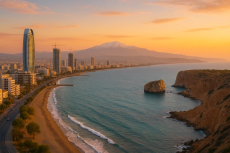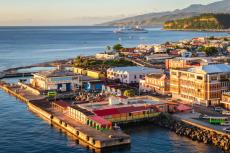Blog • Published on:April 23, 2025 | Updated on:April 23, 2025 • 13 Min
Malta Visa-Free Countries: Complete List of 2025 Visa-Free & Visa on Arrival Destinations
As of 2025, Maltese passport holders enjoy visa-free or visa-on-arrival access to 188 countries and territories, ranking the Maltese passport 7th globally in terms of travel freedom, tied with Poland and Canada.
This extensive access is attributed to Malta's membership in the European Union and its participation in various international agreements. The Maltese passport allows for free movement and residence in all EU member states, as well as countries in the European Economic Area and Switzerland.
In addition to visa-free access, Maltese citizens benefit from the right to consular protection from other EU countries when in non-EU countries where Malta does not have an embassy.
The Maltese passport is a biometric travel document that facilitates international travel and identification. It is issued to citizens of Malta and is valid for 10 years for individuals aged 16 and over, and 5 years for minors under 16.
Visa-free countries for Maltese passport holders in 2025
What Does Visa-Free Mean for Maltese Passport Holders?
When a country is visa-free for Maltese nationals, it means you don’t need to apply for a visa before arriving. There's no embassy paperwork, no processing delays, just book your flight and go. This typically allows for short stays, often ranging from 30 to 90 days, and is valid for tourism, business meetings, or visiting friends and family.
But it doesn’t give you the right to work or study. That still requires a permit in most cases (unless it's within the EU, where you're treated like a local).
Why Malta Has One of the World’s Most Travel-Friendly Passports
The Maltese passport ranks in the top tier globally, not because of geographic size or political power, but due to smart diplomatic ties and EU membership. As a citizen of Malta:
- You can live, work, and study freely in all EU countries.
- You enjoy uncomplicated access to North America, most of Asia, and Oceania.
- Your passport is welcomed without scrutiny in over 180 destinations.
This makes it a practical choice for entrepreneurs, investors, and global families who value flexible mobility.
How Long Can You Stay in Visa-Free Countries?
Each country has its own rules for visa-free stays. Here’s a quick reference:
It’s always smart to double-check entry policies before your trip, especially in regions with shifting political conditions or recent updates.
Can You Extend a Visa-Free Stay?
Some countries allow short-term visa extensions, others don’t. For example:
- Thailand may allow an additional 30 days.
- Japan typically does not.
- Schengen countries will not extend beyond 90 days across the bloc unless you obtain a special long-stay visa.
Have a complete look at current and upcoming Schengen countries in our latest guide: Upcoming Schengen Countries List.
If you're planning an extended adventure, consider destinations with flexible tourist visa policies, or alternate your stay between countries with different visa zones.
What Can You Do with Visa-Free Entry?
Visa-free doesn’t mean unrestricted. In general, here's what you're legally allowed to do:
- Tourist activities
- Attend business meetings
- Visit family or friends
- Participate in short-term training or conferences
But you cannot:
- Work for a local employer
- Enroll in full-time education
- Use visa-free status for residency
Visa on Arrival Countries for Maltese Citizens in 2025
What Does “Visa on Arrival” Actually Mean?
When you travel to a visa on arrival (VoA) country, it means you don’t need to apply for a visa in advance at an embassy. Instead, you get the visa directly at the airport or land border crossing of your destination country.
It usually takes 5–20 minutes, involves a simple form and a fee (sometimes in cash only), and grants you temporary entry, typically for 15 to 90 days depending on the destination.
Required Documents for Visa on Arrival
Even though pre-approval isn’t needed, VoA still comes with some conditions. You’ll usually need:
- A valid passport (with at least 6 months’ validity)
- Proof of onward or return travel
- Hotel booking or address of stay
- Sufficient funds for the duration of your trip
- Local currency or USD for the visa fee (varies by country)
Some countries like Nepal or Tanzania have digital kiosks at the airport, while others still rely on paper forms.
Typical Stay Durations & Costs
Here’s what you can usually expect:
Some countries offer visa extensions, but they’re not always straightforward. For example, Sri Lanka lets you extend online, while Madagascar requires in-person processing.
Key Considerations Before You Fly
While VoA is convenient, it's not always risk-free:
- Some countries limit VoA to certain entry points only (e.g., major international airports).
- If you land in a small regional airport or cross at a land border, VoA might not be available.
- Not all immigration officers have the same interpretation of VoA rules, having printed confirmations helps.
Also, during high seasons or political shifts, entry requirements can change temporarily. Always double-check with the destination’s official government or consulate website before traveling.
Should You Rely on Visa on Arrival?
Visa on arrival is great for last-minute travelers, especially in regions like Africa, South Asia, and Oceania. However, if you're planning a long stay or multiple entries, consider getting an eVisa or a traditional visa to avoid surprises.
Here’s when VoA makes the most sense:
- You’re on a short vacation
- Your itinerary includes flexible entry points
- You prefer fewer pre-travel admin steps
eVisa Countries for Maltese Citizens in 2025
What Is an eVisa and How Does It Work?
An eVisa is a digital visa that you apply for online, before you travel. Unlike visa on arrival, you’ll need to fill out a form, upload documents, and pay the fee via a government portal. Once approved, you receive a digital confirmation (usually a PDF), which you present at immigration.
It’s faster than traditional visas but requires advance planning.
How Long Does It Take to Get an eVisa?
Most eVisa systems are built for efficiency. Here’s what to expect:
Make sure your email is active, and you have access to a printer (or digital wallet) when traveling.
Documents You’ll Usually Need for eVisa
Every country differs slightly, but in general:
- A valid passport (usually 6+ months validity)
- Digital photo (passport-size)
- Itinerary or proof of travel
- Hotel reservation or address of accommodation
- Credit or debit card for online payment
Some systems like India’s eVisa platform also request scanned passport bio pages and additional info on your background.
Where Are eVisas Commonly Used?
eVisa systems are gaining ground fast in:
- East and West Africa – Kenya, Ethiopia, Angola
- South Asia – India, Bhutan, Sri Lanka
- Central Asia – Tajikistan, Azerbaijan
- Oceania – Papua New Guinea
- Strategic Middle East zones – Bahrain
These regions often lack physical embassies, so eVisas reduce friction for visitors.
Common Mistakes to Avoid with eVisas
- Wrong website – Always use the official government site (not a third-party service).
- Spelling errors – Mismatches between your passport and application can lead to rejection.
- Late application – Some eVisas take up to 10 days. Don’t leave it for the week of your trip.
Pro tip: Always carry a printed copy of your approved eVisa, even if the confirmation says “digital only.”
Standard Visa Requirements for Maltese Passport Holders in 2025
Even with a high-ranking passport, there are still a few countries where Maltese citizens must obtain a visa in advance. This typically applies to destinations with:
- Tighter immigration control
- Limited diplomatic relations
- Security or economic constraints
These visas often require an in-person application, background checks, and sometimes a personal interview at an embassy or consulate.
Where Do Maltese Citizens Still Need a Visa?
As of 2025, here are some destinations where a traditional visa is still required:
These destinations typically involve longer processing times, supporting documents, and higher rejection risks.
What’s Usually Required for a Standard Visa?
Depending on the country, expect to provide:
- Valid passport (6+ months)
- Visa application form (online or paper)
- Passport photos
- Travel itinerary (flights + hotel bookings)
- Bank statements or proof of funds
- Travel insurance
- Visa fee payment receipt
- Embassy appointment (in some cases)
Some embassies only operate in neighboring countries. For example, to apply for a Turkmenistan visa, Maltese travelers may need to go through a consulate in Vienna or Berlin.
Is It Still Worth Visiting These Countries?
Absolutely, if you’re up for the paperwork. Many visa-required countries offer unique cultural or natural experiences, like:
- Hiking in the Tian Shan Mountains of Kyrgyzstan (requires eVisa or VoA, depending on entry point)
- Exploring ancient Nubian temples in Sudan
- Attending the Ice Festival in Harbin, China
But make sure you plan early, gather documents in advance, and stay up to date with foreign ministry advisories.
Duration of Stay in Visa-Free Countries
Just because you don’t need a visa to enter doesn’t mean you can stay as long as you like. Each country has a clear limit on how many days you can remain without a visa, and overstaying can lead to fines, bans, or issues with future travel.
We'll break this down into two main categories: short-term stays and extended stay options.
Short-Term Stays (Up to 90 Days)
This is the most common category for visa-free travel. Maltese passport holders can visit most destinations for a set period, usually 30, 60, or 90 days, without any special paperwork.
Here’s a quick guide to some key durations:
Important: "90 days" doesn’t mean you can just reset it by crossing the border for a day and coming back. For regions like Schengen, it's 90 days in any 180-day period across the whole bloc.
Extended Stay Options
If you plan to stay longer, there are a few strategies:
1. Apply for a Long-Term Visa
Some countries offer national visas, or residence permits if you're staying for work, study, or family reasons. Examples:
- France: Long-stay visitor visa for up to 1 year
- Portugal: Digital nomad visa (D7 or D8 options)
- Thailand: Long-Term Residence (LTR) visa or education visa
- UAE: Remote Work Visa (1-year renewable)
2. Exit-Reentry Strategies (Regional Travel Loops)
For countries outside Schengen (like Mexico or Panama), you can leave at the end of your stay, spend time in a neighboring country, and then re-enter to reset your tourist allowance. Still, overuse of this method may draw scrutiny from immigration officers.
3. Switch to an eVisa or Visa on Arrival
Some travelers extend their stay by switching status, for example, entering visa-free and then applying for an eVisa while inside the country (this is rare but possible in places like Sri Lanka).
Quick Comparison: Short-Term vs. Long-Term Options
Travel Privileges with Maltese Citizenship in 2025
Being a citizen of Malta comes with more than just access to sandy beaches and a relaxed Mediterranean lifestyle. It gives you one of the world’s most globally mobile passports, backed by strong international agreements, EU protections, and consular rights.
Here’s what that means in practical terms when you travel.
1. Visa-Free Access to 180+ Countries
As of 2025, Maltese citizens enjoy visa-free or visa-on-arrival access to 188 destinations. This includes nearly all of Europe, much of Asia, North and South America, Oceania, and select countries in Africa and the Middle East.
Few passports offer such a wide footprint, especially with minimal administrative hurdles. This puts Malta on par with countries like Canada, New Zealand, and Switzerland when it comes to border access.
2. Full EU Freedom of Movement Rights
One of the most powerful privileges of Maltese citizenship is your automatic right to live, work, study, and retire in any EU member state, without a visa or work permit.
This includes:
- 28 EU countries (including newer members like Croatia and Romania)
- Iceland, Liechtenstein, Norway, and Switzerland via EEA agreements
- Access to public healthcare and education systems when residing in other EU countries
- The ability to start a business or be self-employed without immigration barriers
This is especially valuable for entrepreneurs, students, and remote workers who want flexibility across an entire continent.
3. EU Consular Protection Abroad
If you're traveling in a country where Malta doesn't have an embassy or consulate, you’re not left unprotected. As an EU citizen, you have the right to receive consular assistance from any other EU embassy or consulate in that country.
Let’s say you lose your passport in Laos and Malta doesn’t have a diplomatic mission there, you can walk into the German, French, or Italian embassy and receive help as if you were their own citizen.
4. Strong Diplomatic Reputation & Low Scrutiny
Maltese citizens benefit from the country’s reputation as a neutral, non-threatening, and cooperative nation. That means:
- Fewer instances of secondary screening at airports
- Smoother processing at borders
- Less likelihood of being singled out for additional security checks
This “low-risk” passport status is especially helpful when entering countries with tight border policies like the U.S., Canada, or Japan.
5. Dual Citizenship Without Travel Penalties
Malta recognizes dual and even multiple citizenships. This means you can hold other nationalities without losing your Maltese status, and travel under whichever passport gives you the best access.
It’s particularly useful for investors or digital nomads who structure their lives around visa-free access or tax-friendly jurisdictions.
Explore the list of countries that permit dual nationality, including with the U.S., in our blog: Dual Citizenship: USA Eligible Countries
Travel Freedom Starts with the Right Passport
A strong passport doesn’t just save you time at airports, it reshapes your entire lifestyle. For Maltese citizens in 2025, the ability to move freely across continents, settle in Europe, and tap into diplomatic protection is more than just convenient, it's empowering.
Whether you're a global entrepreneur, a frequent flyer, or someone seeking better options for your family’s future, Malta offers one of the most attractive citizenship programs in the world.
A Quick Look at the Malta Citizenship by Naturalisation for Exceptional Services
Malta’s citizenship program is based on exceptional services by direct investment, allowing eligible individuals to become citizens within 12 to 36 months, depending on the residence track chosen.
Key facts:
- Residency required before applying for citizenship (12 or 36 months)
- Investment includes:
- A contribution to the National Development Fund
- Real estate investment (rental or purchase)
- A donation to a registered Maltese NGO
- Full EU citizenship with rights to live, work, and study across Europe
- Passed on to future generations
This route is designed for high-net-worth individuals who meet Malta’s due diligence and financial criteria.
If you’re exploring the Maltese citizenship route, it’s not something you want to handle solo. There are multiple legal, tax, and documentation layers to manage correctly. Reach out today to discuss your eligibility and map out a tailored strategy toward EU citizenship with the freedom that comes with it.
FAQs on Maltese Passport and Visa-Free Travel
1. How many countries can Maltese citizens visit without a visa in 2025?
As of 2025, Maltese passport holders have visa-free or visa-on-arrival access to 188 countries and territories. This extensive access underscores Malta's strong diplomatic relations and its status within the European Union.
2. What is the maximum duration Maltese citizens can stay in Schengen countries without a visa?
Maltese citizens can stay in Schengen Area countries for up to 90 days within any 180-day period without a visa. This rule applies collectively across the Schengen Zone, meaning the 90-day limit is for the entire area, not per individual country.
3. When will the European Travel Information and Authorisation System (ETIAS) be implemented, and will Maltese citizens need to apply?
ETIAS is expected to be operational in mid-2025. However, as Malta is an EU member state, Maltese citizens will not be required to apply for ETIAS when traveling within the Schengen Area. ETIAS is designed for visa-exempt non-EU nationals.
4. What are the requirements for obtaining Maltese citizenship through exceptional services by direct investment?
Applicants must first obtain Maltese residency and maintain it for either 12 or 36 months, depending on the investment level. Requirements include a non-refundable government contribution, investment in real estate, a donation to a registered Maltese NGO, and passing a thorough due diligence process.
5. Does Malta allow dual or multiple citizenships?
Yes, Malta permits dual and multiple citizenships. Since amendments to the Maltese Citizenship Act in 2000, citizens can acquire and retain foreign citizenships alongside Maltese citizenship.
References
Aġenzija Komunità Malta. (n.d.). Acquisition of Citizenship. Retrieved from https://komunita.gov.mt/en/services/acquisition-of-citizenship/
European Commission. (2025). Travel documents issued by third countries and territorial entities (Part I). Retrieved from https://home-affairs.ec.europa.eu/travel-documents-issued-third-countries-and-territorial-entities-part-i_en
European Union. (2025). Welcome page - European Union. Retrieved from https://travel-europe.europa.eu/index_en
Government of Malta. (2024, November 22). Malta concludes visa-free agreement with China. Retrieved from https://govcms.gov.mt/en/Government/DOI/Press%20Releases/Pages/2024/11/22/pr241903en.aspx
Residency Malta Agency. (n.d.). The Malta Permanent Residence Programme. Retrieved from https://residencymalta.gov.mt/the-mprp-programme/Residency Malta+3Residency Malta+3Residency Malta+3
Written By

João Silva
João Silva is a seasoned consultant in the global mobility industry with over 12 years of experience. Specializing in European residency and citizenship by investment programs, João has assisted hundreds of high-net-worth clients in securing their second citizenship through strategic investments in real estate and government bonds.
Related Articles









Recently Published









Book a free consultation


